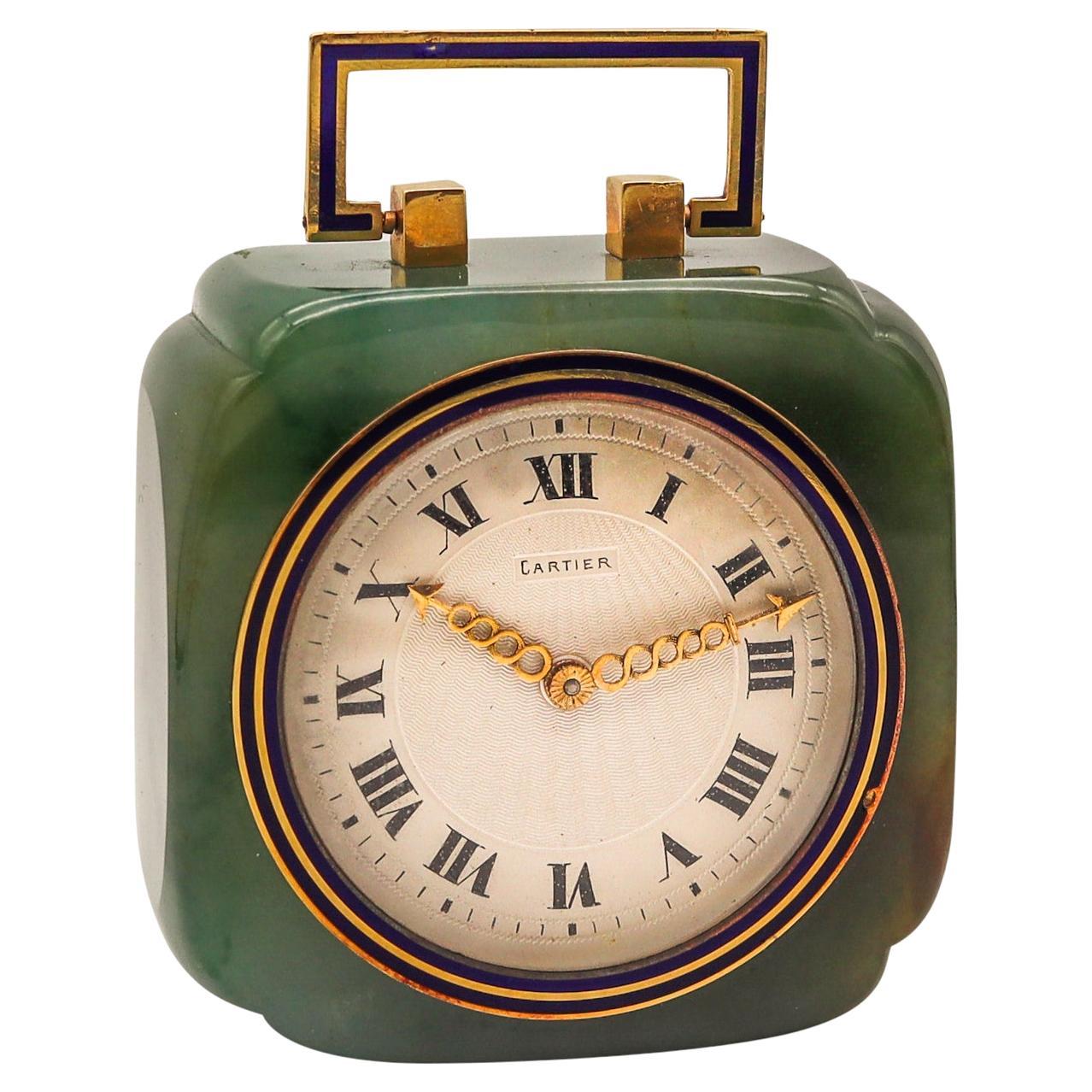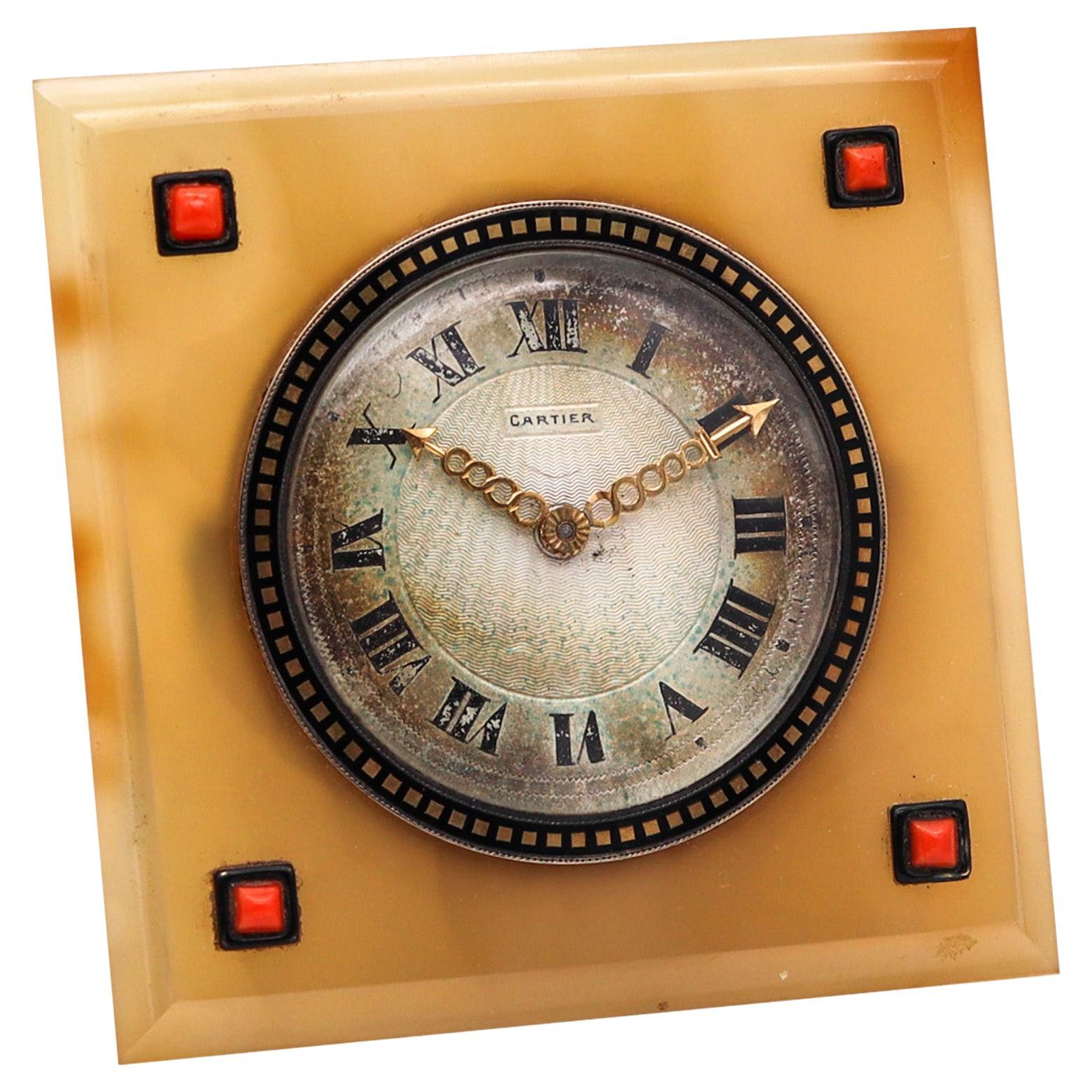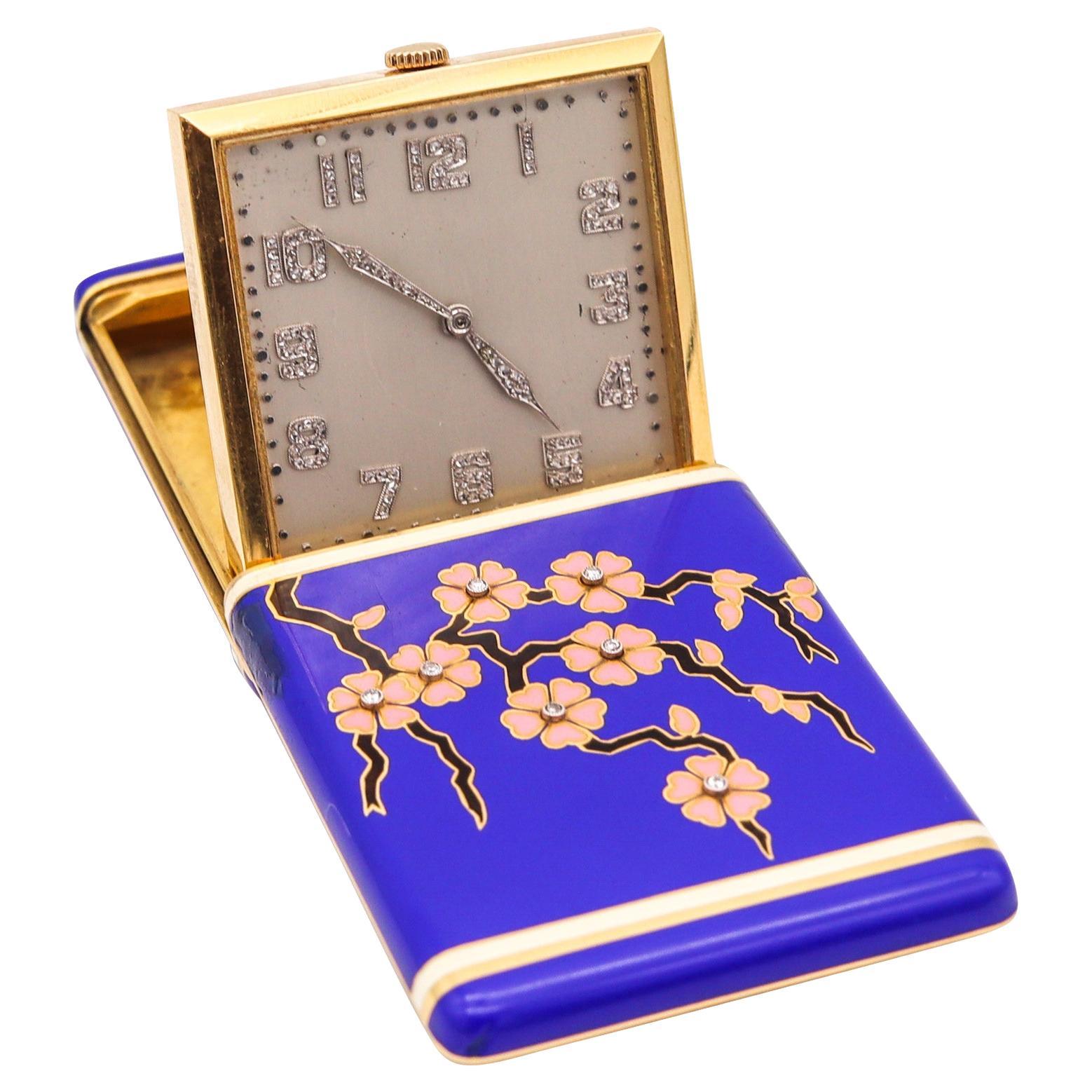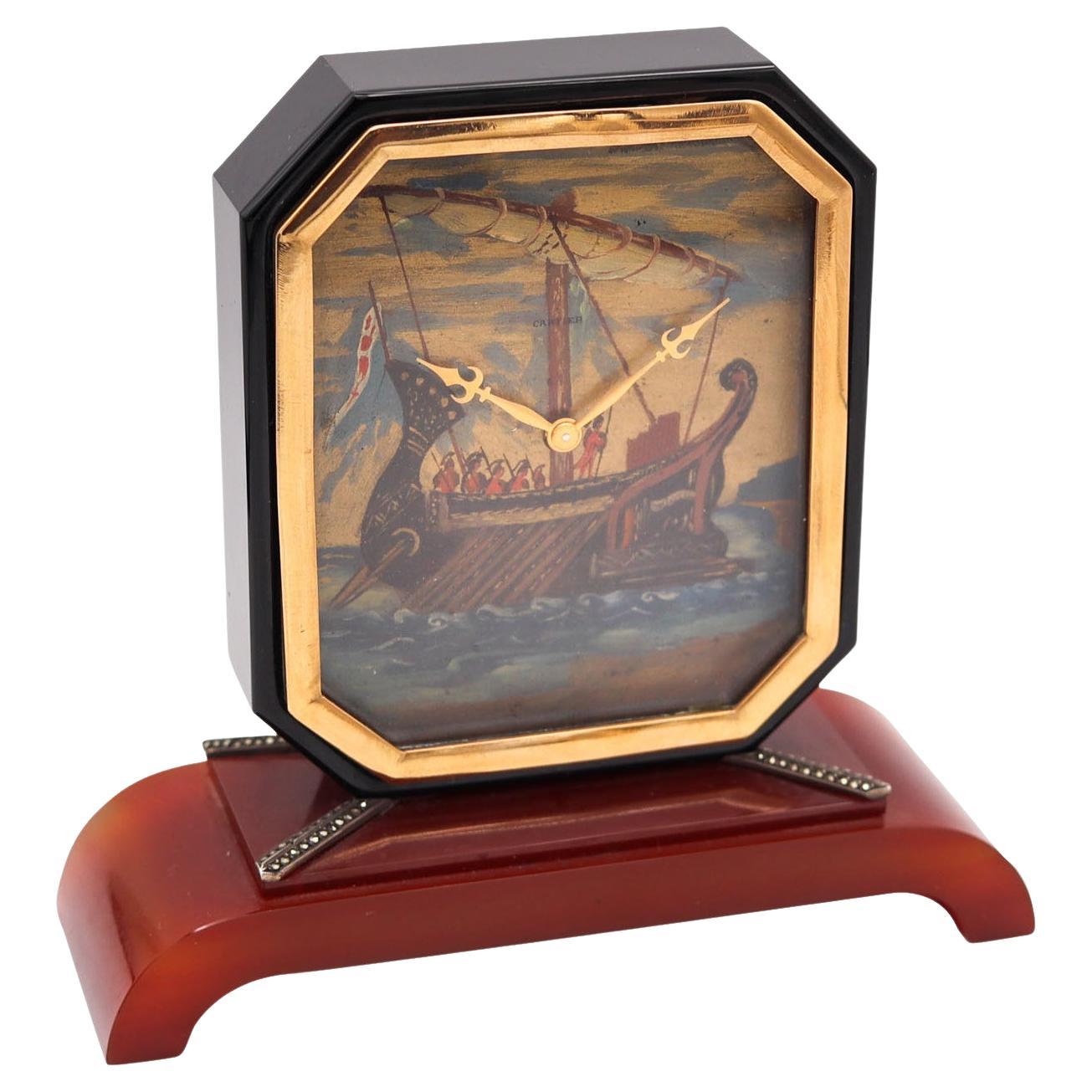Cartier Paris London 1905 Belle Epoque Enamel Clock 18kt Gold Platinum & Silver
About the Item
- Creator:
- Metal:
- Stone:
- Stone Cut:
- Weight:272.8 g
- Dimensions:Width: 1.85 in (46.99 mm)Depth: 1.57 in (39.88 mm)Length: 2.75 in (69.85 mm)
- Style:
- Place of Origin:
- Period:
- Date of Manufacture:1905
- Condition:Wear consistent with age and use. The overall condition of this desk clock is impeccable. Beside the little normal wear, there is no damage to the gold or the enamel. All parts and diamonds are secured in the settings. This piece has been carefully inspected to guarantee is working.
- Seller Location:Miami, FL
- Reference Number:
Cartier
For its extraordinary range of bracelets, watches, rings and other adornments, French luxury house Cartier is undeniably one of the most well known and internationally revered jewelers in the world among clients both existing and aspirational.
Perhaps 1847 was not the ideal time to open a new watchmaking and jewelry business, as the French Revolution was not kind to the aristocracy who could afford such luxuries. Nevertheless, it was the year Louis-François Cartier (1819–1904) — who was born into poverty — founded his eponymous empire, assuming control of the workshop of watchmaker Adolphe Picard, under whom he had previously been employed as an assistant. Of course, in the beginning, it was a relatively modest affair, but by the late 1850s, Cartier had its first royal client, Princess Mathilde Bonaparte, niece of Napoleon Bonaparte, who commissioned the jeweler to design brooches, earrings and other accessories.
Under the leadership of Louis-François’s son, Alfred, who took over in 1874, business boomed. Royalty around the world wore Cartier pieces, including Tsar Nicholas II of Russia, the Maharaja of Patiala and King Edward VII, who had 27 tiaras made by the jewelry house for his coronation in 1902 and issued Cartier a royal warrant in 1904. (Today, the British royal family still dons Cartier pieces; Kate Middleton, Duchess of Cambridge, regularly sports a Ballon Bleu de Cartier watch.)
Cartier’s golden years, however, began when Alfred introduced his three sons, Louis, Pierre and Jacques, to the business. The brothers expanded Cartier globally: Louis reigned in Paris, Pierre in New York and Jacques in London, ensuring their brand’s consistency at their branches across the world. The trio also brought in such talents as Charles Jacqueau and Jeanne Toussaint.
One of Cartier’s earliest major successes was the Santos de Cartier watch — one of the world's first modern wristwatches for men. (Previously, a large number of people were using only pocket watches.) Louis designed the timepiece in 1904 for his friend, popular Brazilian aviator Alberto Santos-Dumont, who wanted to be able to check the time more easily while flying.
Cartier’s other famous timepieces include the Tank watch, which was inspired by the linear form of military tanks during World War I, and the so-called mystery clocks. Invented by watchmaker and magician Jean-Eugène Robert-Houdin and later crafted exclusively for Cartier in the house’s workshop by watchmaker Maurice Couët, the mystery clocks were so named because the integration of glass dials on which the clocks’ hands would seemingly float as well as structures that are hidden away within the base give the illusion that they operate without machinery.
On the jewelry side of the business, Cartier’s internationally renowned offerings include the Tutti Frutti collection, which featured colorful carved gemstones inspired by Jacques’s trip to India and grew in popularity during the Art Deco years; the panthère motif, which has been incorporated into everything from brooches to rings; and the Love bracelet, a minimal, modernist locking bangle inspired by medieval chastity belts that transformed fine jewelry.
While the Cartier family sold the business following the death of Pierre in 1964, the brand continues to innovate today, renewing old hits and creating new masterpieces.
Find contemporary and vintage Cartier watches, engagement rings, necklaces and other accessories on 1stDibs.
- ShippingRetrieving quote...Ships From: Miami, FL
- Return PolicyA return for this item may be initiated within 1 day of delivery.
- Cartier Paris 1910 Belle Epoque Enamel Desk Clock Gold Platinum Silver DiamondsBy CartierLocated in Miami, FLBelle epoque desk clock designed by Cartier. A very rare and magnificent round desk clock, created in Paris France by the house of Cartier, during the Edwardian Belle Epoque period,...Category
Vintage 1910s French Edwardian Enamel Frames and Objects
MaterialsDiamond, White Diamond, Gold, 18k Gold, Yellow Gold, Platinum, Silver, E...
- Cartier Paris 1920 Art Deco Chinoiserie Desk Clock Nephrite Enamel & 18Kt GoldBy CartierLocated in Miami, FLA desk clock designed by Cartier. An impressive and beautiful desk clock, created in Paris France by the house of Cartier, during the art deco per...Category
Vintage 1920s French Art Deco Desk Accessories
MaterialsJade, Gold, 18k Gold, Yellow Gold, Enamel
- Cartier Paris 1925 Art Deco Enamel Desk Clock In 18Kt Gold Agate And CoralBy CartierLocated in Miami, FLBelle epoque desk clock designed by Cartier. Beautiful square desk clock, created by the house of Cartier, during the art deco period, back in the 1...Category
Vintage 1920s French Art Deco Desk Accessories
MaterialsAgate, Coral, Gold, 18k Gold, Yellow Gold, Silver, Enamel
- Art Deco 1925 Japonism Enameled Travel Clock in 18kt Yellow Gold with DiamondsLocated in Miami, FLA travel clock designed by Cress Arrow Co. An incredible travel-desk clock, created in America during the art deco period by the jewelry and luxury watches makers Cress Arrow Co., back in the 1925. This fabulous flamboyant piece is a truly magnificent work of Art Deco jewelry art and has been crafted with very elegant Japonism patterns in solid yellow gold of 18 karats with accents in platinum for the setting of the diamonds. The piece is decorated in both sides with abstract images of the Japan national tree of the cherry blossom, entirely embellished with applications of blue, black and rose enamels. It is fitted with a slider mechanism to discover the dial and stand in the desk. The movement is Swiss, mechanical hand winding. The dial is silver with platinum arabic numbers and arrows, signed Swiss. Japonesque, Japonism or Japonaiserie are French terms that refers to the popularity and influence of Japanese art and design among a number of Western European artists during the late 19th century, the art nouveau and the art deco period. Diamonds: The platinum arabic numbers and the arrows are with 144 old European rose cut diamonds, 1.08 carats, E/F color, VS-1 clarity. Weight: 109.35 Grams, (70.09 Dwt). Measurements: 57 mm by 45 mm by 9 mm (2.24 x 1.77 x 0.35 Inches). Hallmarks: Stamped with the maker's mark monogram, the reference serial numbers, the gold assay marks and signed, "CRESSARROW 18K 63086-086". The Cressarrow Company Was originally formed as a jewelry manufacturer in Newark New Jersey in 1890 as the N.E. Whiteside & Co and was succeeded by Whiteside and Blank in 1903. The firm manufactured 14 carat brooches, scarf pins, sleeve buttons, studs, and bracelets, accented with enamel. Later they produced high quality jewelry in platinum. The United States Patent and Trademark Office registration indicates that the C with the arrow through it was first used for brooches, cuff-buttons, pendants, necklaces and rings by the original firm beginning in 1890. In 1911, the company was awarded the exclusive licence to sell the expansion bracelet that had been invented in Germany. The venture became immediately successful and Whiteside and Blank devoted more and more time to the watch business, becoming the first in the United States to make wrist watches for ladies...Category
Vintage 1920s American Art Deco Desk Accessories
MaterialsDiamond, White Diamond, Gold, 18k Gold, Yellow Gold, Platinum, Enamel
- Cartier Paris 1935 Rare Art Deco Geometric Desk Clock in Black Onyx and AgateBy CartierLocated in Miami, FLA desk clock designed by Cartier. A beautiful and sober desk clock, created in Paris France by the the house of Cartier during the late art deco period, back in the early 1935. This desk clock is very rare and has been designed with geometric art deco patterns and assembled from several polished pieces carved from natural black onyx and reddish translucent agate. All parts mounted in gilded bronze and sterling silver settings of .935/.999. Movement: Swiss mechanical wingding Imhof movement, Caliber 244, Fifteen Jewels, 8 days, Serial. The dial is octagonal with a unique painted scene depicting an ancient Greek ship, most probably from the Homer's Iliad or related to the wars of Troy. Analog without numbers and with golden hands and inscribed, Cartier Swiss...Category
Vintage 1930s French Art Deco Desk Accessories
MaterialsAgate, Onyx, 18k Gold, Sterling Silver, Bronze
- Cartier Paris 1900 Edwardian Guilloche Enamel Pin 18Kt Gold Platinum And DiamondBy CartierLocated in Miami, FLBelle Epoque pin designed by Cartier. Colorful and very rare stick pin made during the Edwardian-Belle Epoque period. This beautiful piece was created in Paris France by the jewelry house of Cartier, back in the 1900. Carefully crafted in two parts made up of solid platinum, yellow and white gold of 18 karats. Embellished with a central panel decorated with engine turned guilloche topped with purple glossy enamel. Accented with thirty-five natural earth mined rose cut diamonds and the settings are finished with millegrain. Diamonds: Mounted in millegrain settings, with 35 old rose cut diamonds, 0.30 carats, G/H color, SI-1 clarity. Weight: 2.35 Grams, (1.51 Dwt). Measurements: 70 mm by 12 mm (2.76 x 0.47 Inches). Hallmarks Stamped with French marks, the maker's maitre mark CA inside a lozange cartouche, the head of the eagle for the assay and warranty of the gold, the four digits serial numbers and signed, "CARTIER PARIS 3840". Cartier The move to the rue de la Paix coincided with a period of extraordinary economic growth and affluence in France and the world. Cartier was also growing and expanding and had started to shift their emphasis from retailing to design and manufacture. Although they produced a small number of pieces in the Art Nouveau style, Cartier paid scant attention to the movement. They made their distinguishing mark in pioneering the use of platinum in creating the delicate and graceful Garland style that came to be associated with the Belle Époque. The discovery of the great diamond deposits in South Africa in the late 1860’s engendered the popularity of extravagant diamond jewelry. The technical advances in the manufacturing of platinum enabled designs of great intricacy, strength and flexibility such as found in the spectacular résille designs of Cartier. (See Edwardian Jewelry: 1901-1915). Cartier marked the beginning of the twentieth century by opening branches in London and New York, where their wealthiest and most dedicated clientele resided. The 1902 coronation of Edward VII occasioned a large number of commissions from England’s leading families. Records indicate that Cartier produced twenty-seven tiaras alone for the coronation and the event was instrumental in convincing the firm to seek a permanent presence in London. Indeed, by 1904 they had achieved their first of fifteen royal warrants being appointed official purveyor to the court of King Edward VII. The London branch came to thrive under the tutelage of Alfred’s youngest son, Jacques Cartier, establishing London based design and manufacturing workshops. Opening a Cartier store in New York was a natural progression as many of America’s wealthiest families and business magnates had been traveling to Paris for some time to purchase their jewels from Cartier. By 1906 Alfred had largely retired and Louis and his brother Pierre operated the Cartier business jointly. One of their first major decisions was to establish a New York presence and workshop in 1909 under the skilled direction of Pierre. Indicative of his business skills, Pierre famously secured Cartier’s present location, an elegant Beaux-Arts mansion at 653 Fifth Avenue, from industrialist Morton F. Plant in 1917. The building changed hands in exchange for $100 and a double strand of natural pearls, admired by Plant’s wife and valued at one million dollars, the asking price for the mansion. While the Fifth Avenue location remains priceless to the firm, when the pearls came up for auction in 1957, they fetched a mere $170,000. (From Lang's with thanks). Edwardian Jewelry This Period was during the King Edward VII, after whom this period of jewelry history is named, reigned over England for only nine years, yet the style of jewelry known as “Edwardian” was created roughly between 1890 and 1920. Edwardian-era rings tend to be larger, opulent pieces, and stacked ring designs were popular. The metal surfaces of the rings were often diamond-encrusted for additional shimmer. Each of these rings is a work of art, showcasing a bygone era of grace, elegance and the royalty the Edwardian era is named for. Guilloché This term is used in fine jewelry or objects de Vertu to enhance the appearance of boxes, frames, brooches, rings or pendants. Guilloché enamel refers to metal pieces that have been given the Guilloché treatment and then covered with a translucent layer of enamel, giving the geometric patterns underneath the enamel a colorful hue. Millegrain This is a jewelry technique which refers to the textural effect of a close-set line of metal beads that are typically used as a border on the edges or bezels of jewelry. Literature: Sotheby's fine jewels, London September 17 1021, Lot 146 for an identical piece illustrated with the original box Collateral: It is accompanied by the original Cartier presentation green jewelry box...Category
Antique Early 1900s French Edwardian Drop Necklaces
MaterialsWhite Diamond, Diamond, Enamel, Platinum, Yellow Gold, White Gold, 18k G...
- Belle Époque Cartier Paris Pale Blue Enamel BuckleBy CartierLocated in Bay Harbor Islands, FLThis wonderful enamel buckle by Cartier, Paris features meticulous attention to detail in its very fine enamel work. Dating from around 1890 this 18 karat yellow and rose gold beauty...Category
Antique 1890s French More Objets d'Art and Vertu
Materials18k Gold, Rose Gold, Yellow Gold
- Cartier Paris Belle Epoque Garland Style Enamel Diamond Gold Belt BuckleBy CartierLocated in New York, NYCartier enamel and diamond belt buckle. French The domed rectangular buckle decorated with green guilloché enamel and white enamel borders, set with rose-cut diamond flower-head, c...Category
Early 20th Century French Belle Époque Vanity Items
MaterialsDiamond, 18k Gold, Gold, Enamel
- 1960s Cartier Blue Enamel Manual ClockBy CartierLocated in New York, NYA Cartier Blue Enamel Clock showcasing an Octagonal Dial with Roman Numeral and Manual Movement. A Double Logo C present at the base of the Clock. Made i...Category
Vintage 1960s Desk Accessories
MaterialsEnamel
- Antique Belle Epoque Silver Signet Desk Seal BeautyLocated in Munich, BavariaThis unusual desktop seal in the shape of a beautiful yong lady wearing roses in her swept up coiffure. She is dressed in a low cut dress and wears an important necklace.Category
Antique 1880s Belle Époque Desk Accessories
- Pair James Robinson 18th Cent. Georgian Style Sterling Silver Taper CandlesticksLocated in Philadelphia, PAA fine pair of sterling silver taper candlesticks. By Thomas Bradbury & Son for James Robinson. Each candlestick with a square base with indented & rounded corners supporting a tap...Category
Vintage 1960s English Georgian Desk Accessories
MaterialsSterling Silver
- Antique Belle Époque Hand with Diamond Ring Paperclip Desk Accessory SilverLocated in Munich, BavariaThis beautiful paperclip in the shape of a hand is made out of silver and marked 800. The hand wears a ring with a genuine diamond and an enamelled bracelet.Category
Antique 1890s German Belle Époque Desk Accessories
MaterialsDiamond, Silver
Recently Viewed
View AllRead More
How to Spot a Fake Cartier Love Bracelet
This iconic jewel has captured countless hearts with its elegant design and its amatory symbolism. Counterfeiters have taken note of the demand and created fake versions. If you’re looking for a genuine Cartier Love bracelet, it’s crucial to check all the elements for authenticity. Our guide will teach you the telltale traits of a knockoff.
The 14 Most Iconic Watches for Women
Style, craft and heritage combine to make these designs undeniable classics.






